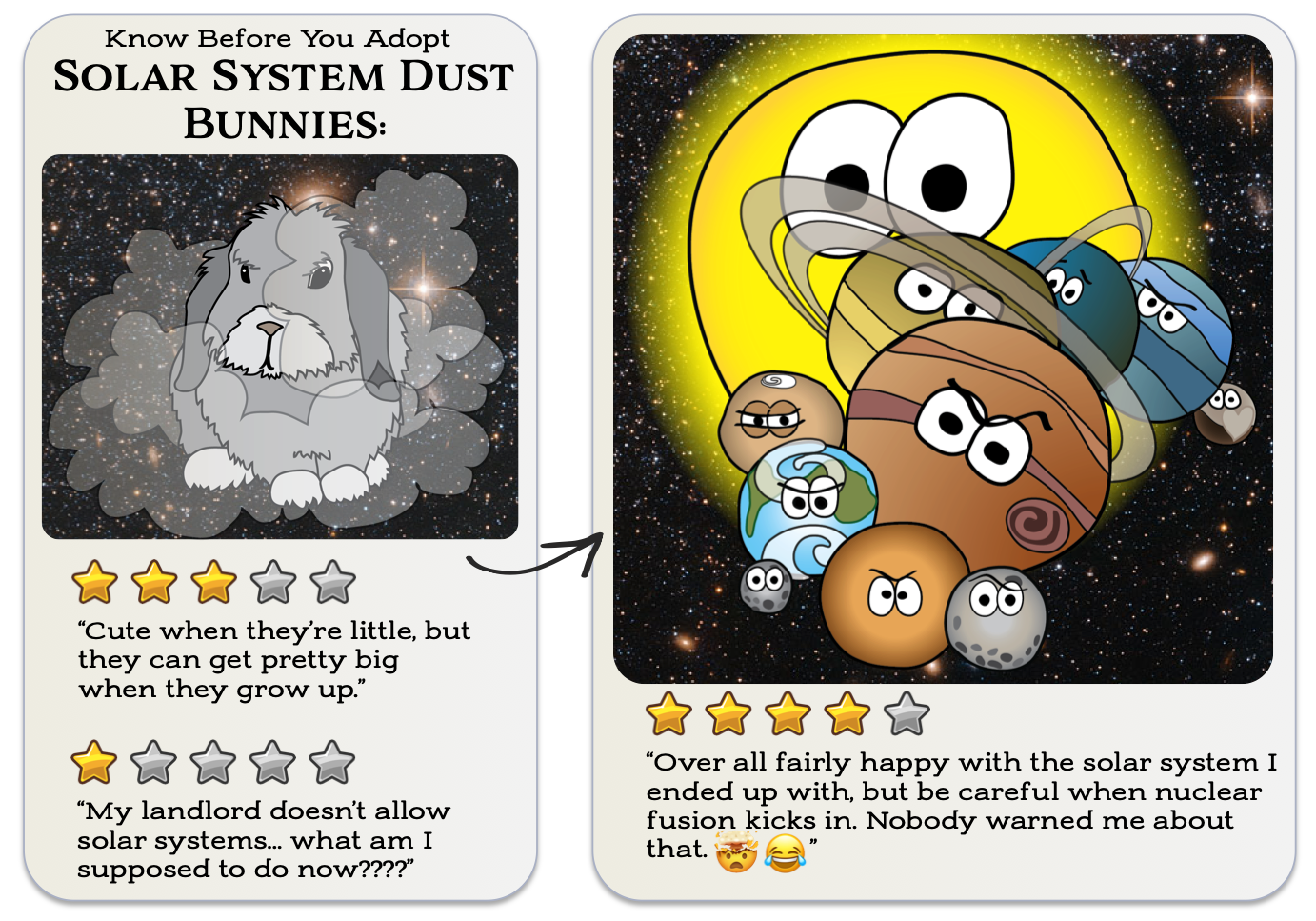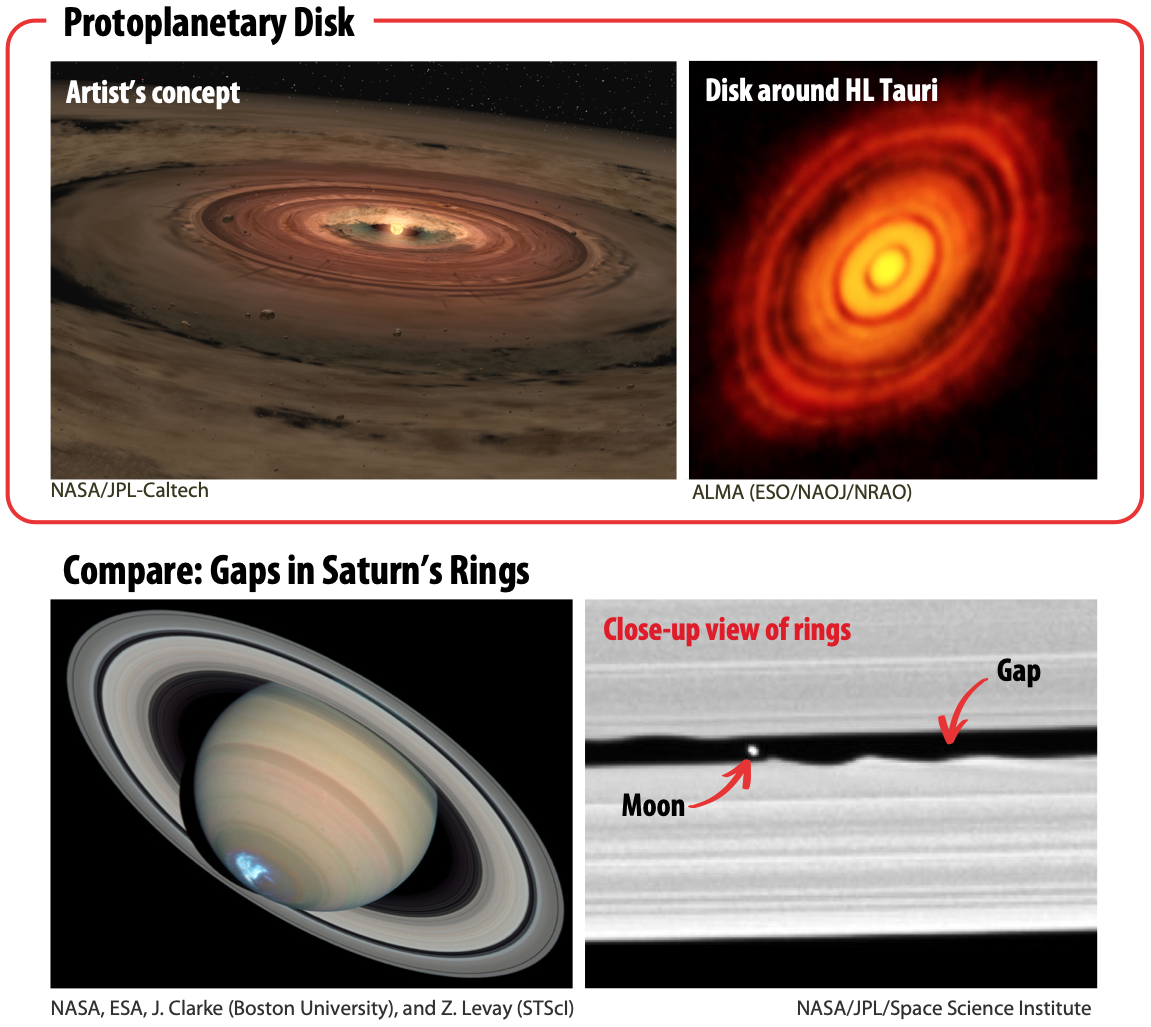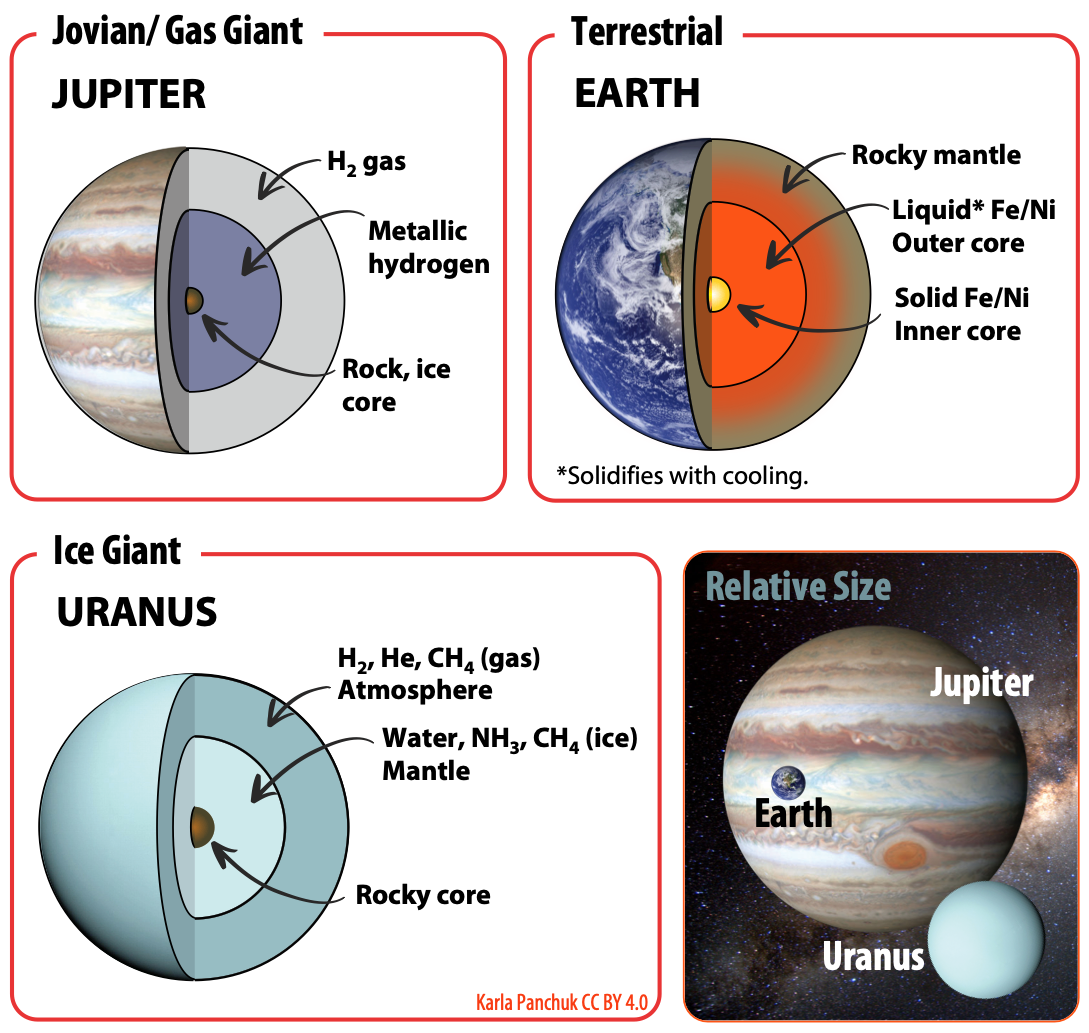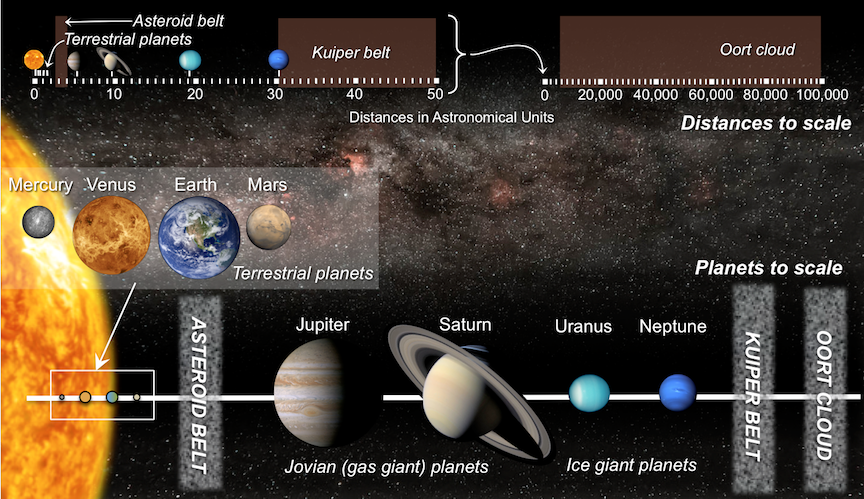2.3 How to Build a Solar System
A solar system consists of a collection of objects orbiting one or more central stars. All solar systems start out the same way. They begin in a cloud of gas and dust called a nebula. Nebulae are some of the most beautiful objects that have been photographed in space. They have vibrant colours from the gases and dust they contain, and brilliant twinkling from the many stars that have formed within them (Figure 2.6). The gas consists largely of hydrogen and helium, and the dust consists of tiny mineral grains, ice crystals, and organic particles.

Step 1: Collapse a Nebula
A solar system begins to form when a small patch within a nebula (small by the standards of the universe, that is) begins to collapse upon itself. Exactly how this starts isn’t clear, although it might be triggered by the violent behaviour of nearby stars as they progress through their life cycles. Energy and matter released by these stars might compress the gas and dust in nearby neighbourhoods within the nebula.
Once triggered, the collapse of gas and dust within that patch continues for two reasons. One reason is that gravitational force pulls gas molecules and dust particles together. But early in the process, those particles are very small, so the gravitational force between them isn’t strong. So how do they come together? The answer is that dust first accumulates in loose clumps for the same reason dust bunnies form under a bed: static electricity. Given the role of dust bunnies in the early history of the solar system, one might speculate that an accumulation of dust bunnies poses a substantial risk to one’s home (Figure 2.7). In practice, however, this is rarely the case.

Step 2: Make a Disk with a Star at Its Centre
As the small patch within a nebula condenses, a star begins to form from material drawn into the centre of the patch. The remaining dust and gas settle into a protoplanetary disk that rotates around the star. The disk is where planets will eventually form. Figure 2.8 (top left) is an artist’s concept of a protoplanetary disk, and Figure 2.8 (top right) is an actual protoplanetary disk surrounding the star HL Tauri. Notice the dark rings within the HL Tauri protoplanetary disk. These are gaps formed by the collection of dust and debris by incipient planets, called protoplanets, as they orbit the star. There is an analogy for this in our own solar system, because the dark rings are akin to the gaps in the rings of Saturn (Figure 2.8, bottom), where moons can be found.

Step 3: Build Some Planets
Types of Planets
Broadly speaking, planets can be classified into three categories based on their composition (Figure 2.9). Terrestrial planets are planets like Earth, Mercury, Venus, and Mars, which have a metal core surrounded by rock. Jovian planets (also called gas giants) are planets like Jupiter and Saturn that are mostly hydrogen and helium. Ice giants are planets like Uranus and Neptune with rocky cores enveloped by water ice, methane (CH4) ice, and ammonia (NH3) ice.

What were the earliest planets like?
Astronomers looking for some of the earliest stars in the universe were surprised to find a planetary system called HIP 11952, which existed 12.8 billion years ago. This was very early in the universe’s history, when stars still consisted largely of hydrogen and helium.
Did HIP 11952 have terrestrial planets?
Answer: No. The planetary system had two Jupiter-sized gas giant planets. Gas giant planets contain large amounts of hydrogen, which was plentiful in the early universe. In contrast, terrestrial planets have heavier elements, especially silica, iron, magnesium, and nickel, that had yet to be manufactured by stars in sufficient abundance to form terrestrial planets.
Arrangement of Solar System Objects
The three types of planets are not mixed together randomly within our solar system. Instead they occur in a systematic way, with terrestrial planets closest to the sun, followed by the Jovian planets and then the ice giants (Figure 2.10).
Smaller solar system objects follow this arrangement as well. The asteroid belt contains bodies of rock and metal. Bodies ranging from metres to hundreds of metres in diameter are classified as asteroids, and smaller bodies are referred to as meteoroids. In contrast, the Kuiper belt (Kuiper rhymes with piper), and the Oort cloud (Oort rhymes with sort), which are at the outer edge of the solar system, contain bodies composed of large amounts of ice in addition to rocky fragments and dust.

This arrangement is related to the temperatures surrounding the young sun. The frost line (or snow line) marks the division between the inner part of the protoplanetary disk closer to the sun, where it was too hot to permit anything but silicate minerals and metal to crystalize, and the outer part of the disk farther from the sun, where it was cool enough to allow ice to form. As a result, the objects that formed in the inner part of the protoplanetary disk consist largely of rock and metal, while the objects that formed in the outer part consist largely of gas and ice.
Concept check: Frost line

How does Tau Ceti’s frost line compare to that of the sun? Choose one:
- Tau Ceti’s frost line is farther from Tau Ceti than the sun’s frost line is from the sun.
- Tau Ceti’s frost line is closer to Tau Ceti than the sun’s frost line is to the sun.
To check your answers, navigate to the below link to view the interactive version of this activity.
Stars don’t start out doing nuclear fusion, but work up to that point by drawing material toward themselves until they attain sufficient mass and density for fusion to begin. During the last stage before fusion begins, young stars blast the protoplanetary disk around them with solar winds (winds made up of energetic particles), which drives lighter molecules toward the outer part of the disk, clearing away many of the materials that can be used to form planets. This puts some time constraints on when planet formation can happen.
Do you know your solar system objects?
Summarize the trends in size and composition of objects in the solar system by dragging the words into the correct boxes.
Closest to the sun we find the small, rocky, with cores. Further out are the , which are the largest in the solar system. They consist mostly of , and have cores of rock and ice. Beyond these are the , which are next largest. They have a mantle of ice (not just water ice but ammonia and methane ice), and a rocky core. Smaller objects in the solar system include rocky bodies within the between Mars and Jupiter, and bodies of ice and dust in the and in the beyond Neptune.
Fill-in-the-blank options:
- gas giant planets
- Oort cloud
- metal
- ice giant planets
- terrestrial planets
- hydrogen
- asteroid belt
- Kuiper belt
To check your answers, navigate to the below link to view the interactive version of this activity.
Rules of the Accretion Game
The objects in our solar system formed by accretion. Early in this process, particles collected in fluffy clumps because of static electricity. As the clumps grew larger, gravity became more important and collected clumps into solid masses, and solid masses into larger and larger bodies. If you were one of these bodies in the early solar system, and participating in the “accretion game” with the goal of becoming a planet, you would have to follow some key rules:
1. Keep your velocity just right. If you move too fast and collide with another body, you both smash up and have to start again. If you move slowly enough, gravity will keep you from bouncing off each other and you can grow larger.
2. Your distance from the Sun determines how big you can get. If you’re closer, there’s less material for you to collect than if you’re farther away.
3. At the beginning you can only collect mineral and rock particles. You have to grow above a certain mass before your gravity is strong enough to hang onto gas molecules, because gas molecules are very light.
4. As your mass increases, your gravity becomes stronger and you can grab material from farther away. The bigger you are, the faster you grow.
You would also have to watch out for some dangers:
- In the early stages of the game, the protoplanetary disk is turbulent, and you and other objects can get thrown into different orbits or at each other. This might be a good thing, or it might not, depending on how the rules above apply to you.
- If the game progresses to the point where there is no more material within your reach and you are not yet a planet, then it’s game over.
- If you slow down too much (e.g., from bumping into other objects), you could spiral into the sun (game over).
- If another planet gets big enough, it can:
- Rip you apart and then swing the pieces around so fast that for the rest of the game you collide too hard with other pieces to grow any bigger (game over)
- Fling you out of the solar system (game over)
- Grab you for itself (game over)
- Trap you in an orbit around it, turning you into a moon (game over, and incredibly humiliating)
Winners and Losers
The outcome of the game is evident in Figure 2.10. Today eight official winners are recognized, with Jupiter taking the grand prize, followed closely by Saturn. Both planets have trophy cases with more than 60 moons each, and each has a moon that’s larger than Mercury. Prior to 2006, Pluto was also counted a winner, but in 2006 a controversial decision revoked Pluto’s planet status. The reason was a newly formalized definition of a planet. Pluto fit the first two requirements: orbiting the sun, and being massive enough to be round. But it didn’t fit the third requirement, that an object can only be considered a planet if it has also swept its orbit clean of other bodies. (This is another criterion related to the mass of the object, as per the rules of the accretion game.) Pluto is situated within the icy clutter of the Kuiper belt, so it doesn’t fit this definition.
Some of Pluto’s supporters argued that Pluto should have been grandfathered in, given that the definition came after Pluto was declared a planet, but to no avail. Pluto has not given up, and on July 13, 2015, it launched an emotional plea with the help of the NASA’s New Horizons probe. New Horizons sent back images of Pluto’s heart (Figure 2.11). On closer inspection, Pluto’s heart was discovered to be broken.

Update: Still Hard Feelings about the Unplaneting of Pluto
Objections to “unplaneting” Pluto are all emotional on some level (see the I Heart Pluto Festival 2021), but scientists can have emotions about their work and still do good science. They keynote speaker at the I Heart Pluto Festival, Dr. Alan Stern gave a talk called “Why Pluto Is a Planet, The Embarrassment of The IAU, and Why They Had It Coming.” Dr. Stern currently leads the New Horizons Mission.
In his talk, Dr. Stern argued first of all that a vote by the IAU was a terrible way to go about making a scientific decision, because whether something is true from a scientific perspective or not has nothing to do with how many people think it should be accepted as truth. As he put it, “The image of the IAU taking a vote was the single most damaging pedagogical event in science in probably a century, because to many people it was easy to reach the conclusion that science is arbitrary or political, which it is not.”
Second, he argued that the definition was changed for the wrong reason, namely that more and more Pluto-sized objects were being discovered past Neptune. (Stern expects there to be hundreds found.) “Astronomers became afraid of astronomically large numbers,” he quipped, and didn’t like the idea of calling all those objects planets.
So what does Dr. Stern think the definition of a planet should be? People who specialize in studying planets define a planet as being massive enough to be round, but not so big that nuclear fusion happens. In other words, round, but not a star. The let the lower limit be defined by how a planet’s mass influences its own shape, rather than by conditions around it that might be unrelated to the object itself (such as a bigger planet flinging debris at it).
In the end, this is an argument about what a good reason is to classify an object one way or another. Dr. Stern is frustrated because he sees the IAU definition as being based on an irrelevant issue, that acknowledging more planets means naming them all. Granted, naming them all means an extraordinary amount of work for the IAU, because you can’t just slap a label on a planet and call it official. There are rules about these things. (The IAU’s webpage Naming of Astronomical Objects begins, “Celestial nomenclature has long been a controversial topic.”) But as Dr. Stern says, “There are countless stars and there are countless planets—and who cares? It’s just the data.”
For more on Dr. Stern’s talk, see Yes, Pluto Is A Planet Says NASA Scientist At The Site Of Its Discovery 91 Years Ago This Week by Jamie Carter (2021, February 15) in Forbes.
The Accretion Game and the Solar System Today
The rules and dangers of the planet-forming game help to explain many features of our solar system today.
- Proximity to the sun explains why the terrestrial planets are so much smaller than the gas giant and ice giant planets.
- Mars is smaller than it should be, given the rule that distance from the sun determines how much material a body can accumulate, and this can be explained by its proximity to Jupiter. Jupiter’s immense gravity interfered with Mars’ ability to accrete. Further evidence of Jupiter’s interference is the debris field that forms the asteroid belt. From time to time, Jupiter still flings objects from the asteroid belt out into other parts of the solar system, some of which have collided with Earth to catastrophic effect.
- The Kuiper belt is an icy version of the asteroid belt, consisting of fragments left over from the early solar system. The material in the Kuiper belt is scattered because of Neptune’s gravity. From time to time, Jupiter interferes here as well, flinging Kuiper belt objects toward the sun and into orbit. As these objects approach the sun, the sun causes dust and gas to be blasted from their surface, forming tails. We know these objects as comets.
- Comets may also come from the Oort cloud where gravitational forces from outside of the solar system can hurl objects from the Oort cloud toward the sun.
Can you build a solar system?

